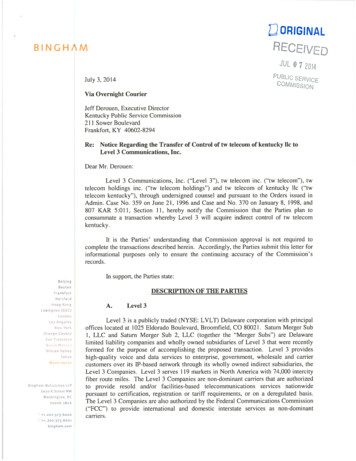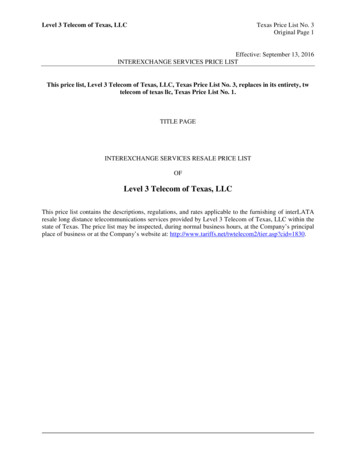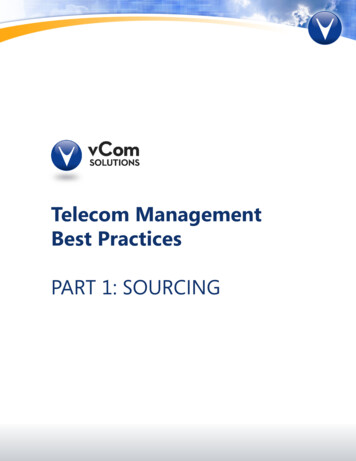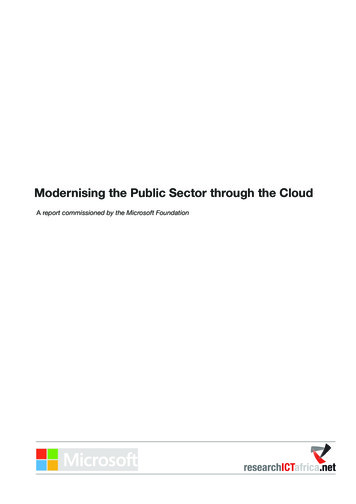
Transcription
Opportunities in TelecomSector:Engaging title in GreenArising from Big DataNovember 2015Second line optional lorem ipsumB Subhead lorem ipsum, date quatueriureDescriptive element inBlue 2 lines if needed
92 2015 Deloitte Touche Tohmatsu India Private Limited
ContentsForeword2Message from Aegis Business School31. Importance of Big Data in Telecom Industry4Benefits of Big Data for Telecom Value Chain6Challenges Faced by Telecom Operators72. Key Technologies9Architecture10Key Technologies in Big Data103. Scope of Big Data Implementation15Call Drop Analysis17Network Analytics18Churn Prediction19Customer Segmentation21Predictive Campaign22Location-Based Services224. Use Cases from Telecom Industry23Customer Churn Predictive Model — Global Telecom Product and Service Provider24Marketing Mix Model — Large Telecommunication Company in the US24Big Data Implementation — Large Telecom Company in the US25Big Data Implementation — Large Online Retailer in Korea25About Deloitte Analytics26About Aegis School of Business, Data Science and unitiesin Telecomin TelecomSector:AddressedArising fromby Big Data1
ForewordEvery day about 2.5 quintillion bytes of data is created.1 This clearly indicates that weare in the era of Big Data. Big data has become a ubiquitous part of telecom industrybecause of the huge amount of data being generated every minute though connectedworld. The upgraded networks and the proliferation of smart devices has enabled thetelecom operators to have access to a wealth of information about their customers’behavior, preferences, movement, etc. Not only human-to-human communication butalso human-to-machine and machine-to-machine (M2M) communication generatehuge amount of data which could be helpful for all industries including telecom. M2Mcommunication is expected to overtake human generated data in the near future.According to Industry analysts, projections are of 32 billion devices generating 44trillion GB of data by 2020.2The telecom and technology companies have been using legacy analytics for years,however, the full potential is yet to be realized by leveraging on the huge amount ofdata that is generated every day from social networks, search engines, governmentportals, online businesses and other applications through real-time predictive analytics.The advanced analytics solutions can provide insights which can help in creating newbusiness models and launch innovative products and services. By leveraging its owndata and combining the data of different sources, telecom operators can gain deeperunderstanding of their customer interaction, product performance, and churn and thuscan improve upon the customer experience and value addition. Telecom companiescan use these insights to help other industries such as agriculture, healthcare,education to name a few.With the growth of technology, big data will become crucial to understand customer,business and the industry itself. Hence, data analytics is becoming an integral part ofevery business.In a study conducted by “Telecoms Intelligence”, 47% of the operators had big datainvestments in place and 19% are expect to implement big data strategy at some pointin 2015, with an additional 16% looking to implement big data in 2016 or beyond.Hyper-competition, slow revenue growth, and increasing network costs will compeltelecom companies to deploy advanced analytics solutions. Increasing network costswill also encourage operators to adopt analytics solutions, which will allow them toimprove data traffic management and optimize the utilization and performance ofnetworks.Although data analytics companies are experiencing 40% annual growth, there is ahuge shortage of talent.3 Big data analytics need professional data scientists who canunderstand the technology of data analytics as well as the business objective of atelecom operator.As telecom operators face high network and spectrum costs and intense competition,advanced analytics will help improving their profitability and gain a competitiveadvantage by enhancing customer experience and optimizing network usage.Articulating a clear value proposition in use of analytics will help justify and attractinvestments.2Hemant Joshi
Message from Aegis BusinessSchoolWhen the whole country is suffering with an epidemic of call drop, Govt. is cluelessabout the actual call drop rate and the exact reasons for the same. Current methods ofcall drop analysis and network analysis is not transparent and representative of actualstatus. We even don’t know what the actual Current Call Drop Rate across the countryor in different geography is. Prime Minister Shri Narendra Modi on 25th August thisyear has directed officials to initiate urgent steps to resolve the problem of call drops.And in the wake of public outcry and Prime Minister making comment TRAI hasrecommended to penalize operators for the same.Absence of proper evidence based diagnostics is leading chaos. Various stakeholdersTRAI, DOT, Operators and associations are not able to have meaningful dialogue andplan a concrete road-map to stop this menace.While this debate is on Retail customer and business, continue to suffer due to calldrop and poor quality of the network.With big data technologies telcos can find out pattern and reasons of call drop in realtime and send customers’ apology text message and also refund money for droppedcalls resulting in improved customer satisfaction and brand value.Bhupesh DaheriaFOunder & CEOAegis School of Business,Data Science andTelecommunicationWe need to build a big data platform on which all the operators need to upload thesample data of CDR, network and billing data after masking subscribers details andthis platform will give provide Dropped-call rate (DCR); patterns of Call Drop; reasonsof call drop and pattern of billing of subscribers and Call Drop etc. This will bringsome transparency in term of network performance and call drop pattern. Once TRAIhas this pattern various stakeholders can discuss why, where and how the call dropis happening and take some proactive actions rather than just thinking of punitiveactions against operators. At Aegis Big Data Product Factory we are developing a CallDrop Analysis platform to analyze call drop rate, patterns and reasons behind it.Crystal ball of big data can help Telco’s see a clear picture in real time as well as act onit too. Hope this white paper helps in addressing a few issues.The white paper on Big Data in Telco is an attempt to put various use cases todevelop action plan and formulate guidelines for managing ongoing challenges intelecommunication.OpportunitiesOpportunitiesin Telecomin TelecomSector:AddressedArising fromby Big Data3
Importanceof Big Data inTelecom Industry4
Indian telecom industry has crossed two decades post privatization of this sector. Sincethen a lot of innovation, consolidation, and maturation have happened in the industry,and today we have 12 major mobile telecom operators operating in the country.Presently, the total revenue of telecom operators is about 1.8 trillion with a burdenof 2.5 trillion debt with a dwindling voice and SMS revenue. This is happening dueto severe tariff competition in case of voice and declining SMS revenue due to theadvent of new instant messaging applications, etc. Operators are facing disruptivetechnologies, rapidly changing business rules, intensified regulatory environmentleading to eroding service margins.In this scenario, the only stabilizing factor for telecom operators is revenue generatedfrom data provisioning and driving value from this data. Telecom operators can useadvanced analytics on customer and network data to generate a real-time view ofcustomer preferences and network efficiency. This could empower them to makenear real-time and fact-based decisions and hence enable a forward looking, focused,decisive, and action-oriented culture in the company.For customers, this brings faster results, predictive power, and new depth to analyticsin the following aspects:Data-enhanced customer experienceAcquiring a deeper understanding of users and improving their experienceat every touchpoint through high performance services, fast feedback andcustomized offeringsData-driven efficiencyTaking advantage of actionable information available within theorganization, combined with insights from the market, in order to workintelligently and reduce costsData driven growthEstablishing innovative offerings and generating new revenue streamssparked by big dataBig data promises to promote growth and increase efficiency andprofitability across the entire telecom value chain.Opportunities in Telecom Sector: Arising from Big Data5
Benefits of Big Data for Telecom Value ChainBig data analytics brings in considerable value to decision making and provide moreaccurate and actionable insights which eventually help to build competitive advantagesand a more efficient cost structure. In comparison to traditional data warehousingtechnologies, big data offers following advantages/ opportunities for telecomoperators: Real-time deep packet inspectionto optimize traffic routing and steernetwork quality of service Cellular network performancemeasurement Data traffic measurement forprovisioning1. Prepare your networks for future demands: Big data helps businesses takeadvantage of the available information within their networks in order to make themrobust, optimized, and scalable. It can help optimize routing and quality of serviceby analyzing network traffic in real time. Reviewing a network from a smartphoneperspective helps reveal areas that require improvement. A revision of 3G-capablesmartphone users running their devices on 2G could identify ways of makingsignificant improvements based on intelligent analysis. Examination of user behaviorcan also play an important role in understanding how to better deliver mediacontent, and thus directly impacting customer experience.NetworkInfrastructureManagement2. Understand customer experience: Big data, with its capabilities, makes it easierto understand your customers in detail right from network data and social mediainformation, which further helps establish customer-centric KPIs which enables tounderstand user experience.Insights can be deployed in customer call centers to better answer and solve concernsfor the customer on the phone and allow them to flexibly and profitably modifysubscriber calling plans immediately. They can be used to tailor marketing campaignsto individual customers using location-based and social networking technologies.They can also be used in Network Operations Centers (NOCs) to discover and handleany issues for bigger groups of users. Where relevant, information can be collectedabout the users’ experience in real time. For example, call center staff could see if thecustomer on the phone has experienced problems at a particular location or whileusing a particular service. The result is an improved customer service, higher levels ofcustomer satisfaction, and a decreased churn rate. Big data can also help analyze calldata records in real time to identify fraudulent behavior immediately.Entire telecom value chain can be benefited by leveraging the Big Data solutions andbelow listed are the proposed areas: Real-time call data record analysisto identify fraud immediately Proactive behavior based and planchanges Total customer usage performancemodeling and measurementServiceAccessIntegration Event-based marketing campaigns thatuse geo-location and social media,allowing differentiated responses Cross- and up-sell targeting (newproduct, upgrade, feature, service) Sale of (anonymous) customer insightsbased on usage data to shops, mediaagencies, etc. New product/service innovation based onreal-time usage patternsMarketing& Sales6
Challenges Faced by Telecom OperatorsBig data has the potential to place communications services providers (CSPs) in a primeposition to win the battle for customers and create new revenue streams. It providesthem with a wealth of information about their customers’ behaviors, preferences, andmovements. Yet, many CSPs struggle to fully derive the greatest value from big data.Customer Information Customer ID Plan Details Demographic Services Spending patternServicesDevice Information BCustomer type Services used (Live TV,Video Call) Customer history Complain category,Queries solved Brand, Model, Series Technology used Content Applications Device historyTelecomOperatorsUsage InformationLocation Information CDR Value added services Average revenue Mobile internet (URLs,Time Spent, Downloads,Content type) Current location Roaming data Frequently visited location GPS based dataAt a macro level, the big data analytics throws many challenges for CSPs because of its variety, velocity, andcomplexity. Variety: The social media networks, connected devices, government portals, call data records, billing information,etc., produce huge amount of data as shown in figure above. Most of the data coming from different sources isunstructured. The telecom players need to enrich their Call Data Records (CDR) with other information like locationbased service, financial information, etc., to standardize the data for business intelligence platforms before theanalysis can be done on it. Velocity: Every minute, Indians spend 1.85 million to shop online. Almost 100 hours of video is shared onYouTube every minute.4 The average time spent by a social media user in India is 2.5 hours a day.5 All this pointsto the fact that the data generation speed is tremendously high and to gain value from this data, it needs to beOpportunities in Telecom Sector: Arising from Big Data7
processed in proper timeframe. This volume of data requires new real-time operational capabilities for variousfunctions and that in turn demands increased data storage for compliance and potential future uses as well as newtools for mediating, managing, and archiving data within available time frames. Complexity: The user generated data is mostly unstructured and complex because of the lack of standard formatto store data. The legacy network and storage devices do not have any specific format to store data which can berelevant for advanced analytics. The data varies with demographics, geography, life style, etc. Analytics may provideunwanted results if the data is not filtered properly.At a micro level, telecom companies faces other challenges while adopting big data for advanced analytics. Determine a strategy how to leverage on the benefits of big data Define criteria for evaluating return on investments Determine business drivers and if big data can play a role in better insight Identifying and acquiring the skill sets required to understand and leverage big data Organizing business analysts team with strong knowledge of company ecosystem Flexibility of infrastructure to interact with various data formats and large volumes Cost and effort associated with scalability Identifying the best software and hardware solutions and determining the best overallinfrastructure solution Transitioning from legacy systems to newer technology Compromise of quality due to volume and variety of data Cost of maintaining all data quality dimensions: completeness, validity, integrity,consistency, timeliness, accuracy Re-evaluation of internal and external data policies and regulatory environment Privacy issues related to direct and indirect use of big data sourcesBig data analytics need professional data scientists who can understand the technology of data analytics and marryit with the business objectives of telecom operator. While there is a shortage of skilled analytics professionals, smalloperators find it unaffordable to hire data scientists. According to analysts, analytics-based companies in India areexpected to face a shortage of 200,000 data scientists.6The infrastructure for data analytics needs high computational capabilities and storage space. It also needs flexibilityto analyze different formats of data. Telecom operators tend to ignore these requirements as it is not a part of theircore business and also to avoid more capital expenditures.Transitioning the historical data from legacy system to new system is a challenge. Data quality is also a roadblock asdifferent equipment provides data in different formats. Data could be inaccurate, and maintaining appropriate qualityof data is a mammoth task for every company.The governance and privacy issues are other major challenges as customers prefer not to share their personal data.Government policies and regulations restrict the operators for independent use of the data.8
Key TechnologiesOpportunities in Telecom Sector: Arising from Big Data9
Data architectures allow telecom companies to store new types of data, retain that data longer, and join diversedatasets together to derive new insights. The following reference architecture diagram represents an amalgam ofthose approaches that we see across our telecom clients.Big data is where the data volume, acquisition velocity, or data representation limits the ability to perform effectiveanalysis using traditional relational approaches or requires the use of significant horizontal scaling for efficientprocessing.Data may be structured, unstructured or semi-structured, and is frequently and extensively inter-changed. Structureddata only accounts for 20% of the big data stored in databases while the rest of 80% is unstructured data.7 Datafrom the internet — including data created by users, data exchanged in social networks, and data from physicalsensing devices and the internet of things — is dynamic and unstructured.ArchitectureData processing in typical big data processing system includes collection and preprocessing, storage, analysis, mining,and value application.Data-source layer consists of data from enterprises, industry, the internet, and the internet of things. In the datacollection layer, the collected data is pre-processed. This pre-processing includes data cleanup and heterogeneousdata processing.In storage layer, structured, unstructured, and semi-structured data is stored and managed. In the data-processinglayer, data is analyzed and mined so that users can analyze services, such as common telecommunications andinternet services on the platform.Key Technologies in Big DataBig data technologies describe a new generation of technologies and architectures, designed to economically extractvalue from very large volume of a wide variety of data by enabling high-velocity capture, discovery, and/or analysis.Many technologies in big data ecosystem have an open source origin. The popularity and viability of these opensource tools have driven vendors to launch their versions of tools.8 For example, Hadoop framework in conjunctionwith additional software components such as R and range of NoSQL - Not only Structured Query Language toolssuch as Cassandra and Apache Hbase is the core of big data.“Telecom providers have a treasure troveof captive data - customer data, CDR, callcenter interactions and tower logs. However,they have been unable to fully exploit thelatent value. Disruptive technologies like- IoT, Big Data and Data Science - offerunprecedented opportunity for data-drivenbusiness optimization in key dimensions ofcost efficiency, customer intimacy and revenuemaximization.” Prasad Shyam, VP and GlobalHead - BI & Analytics, IGATE10
HadoopIt is an open-source software framework for storing data and running applications on clusters of commodityhardware. It provides both distributed storage and computational capabilities. It is a distributed masterslave architecture that consists of the Hadoop Distributed File System (HDFS) for storage and MapReduce forcomputational capabilities.Hadoop consists of following main components: MapReduce - a distributed processing framework Hadoop Distributed File System (HDFS) - distributed file system known Hadoop common - Libraries and utilities used by other Hadoop modules Yarn – Resource management framework for scheduling and handling resource requests from distributedapplicationsFigure 1: Hadoop’s role in the Enterprise Data ArchitectureWebInsightWebApplicationsCustom interface, directqueries and analysisExisting Business InfrastructureIDE &Dev ToolsODS &DatamartsApplications & Visualization nterprise DataWarehouseLow latencywebservices and NoSQLCustomExistingDerive/FilterMapReduceParse and eLogfilesdocumentsImages &video’sExternalsourcesBig Data Sources(transactions, observations, interactions)Source: Deloitte AnalysisOpportunities in Telecom Sector: Arising from Big Data11
Call Detail Records – CDRsApache Flume can ingest millions of CDRs per second into Hadoop, while Apache Storm processes those in real-timeand identifies any troubling patterns. Apache Flume is a distributed, reliable, and available service for efficiently collecting, aggregating, and movinglarge amounts of streaming data into the Hadoop Distributed File System (HDFS) Apache Storm – Real time data processing capabilities to enterprise Hadoop Hadoop facilitates long-term data retention for a root-cause analysis. This CDR analysis could be used tocontinuously improvise on call quality and to help in better marketing campaigns.Fraud detectionThe MapReduce Distribution for Hadoop can help build models that can flag anomalous phone calls that mightindicate theft or hacking, both in business-to-business and business-to-consumer environments.Recommendations – For new launches/ relevant communicationsHadoop Data Lake reduces sales friction and creates NPTB – Next Product To Buy competitive advantage similar toAmazon’s advantages in e-commerce.MapReduceMapReduce is a framework that allows massive scalability across hundreds or thousands of servers in a Hadoopcluster. It allows developers to write programs to process high volumes of unstructured data in parallel across adistributed cluster of processors or stand-alone computers.Figure 2: MapReduce - parallel and distributed processingPrepare Map()inputThe “MapReduce system”designates Mapprocessors, assigns the K1input key value eachprocessor would work on,and provides thatprocessor with all theinput data associated withthat key value.InputKing Smith RiverJones Jones RiverKing Jones SmithSource: Deloitte12Run user-providedMap() codeMap() is run exactly oncefor each K1 key value,generating outputorganized by keyvalues K2.Splitting"Shuffle" Mapoutput to theReduce processorsRun the userprovided Reduce()codeThe MapReduce systemdesignates Reduceprocessors, assigns the K2key value each processorwould work on, andprovides that processorwith all the Mapgenerated data associatedwith thatkey value.MappingKing SmithRiverKing, 1Smith, 1River, 1Jones JonesRiverJones, 1Jones, 1River, 1King JonesSmithKing, 1Jones, 1Smith, 1Reduce() is run exactlyonce for each K2 keyvalue produced by theMap step.ShufflingReducingSmith, 1Smith, 1Smith, 2Jones, 1Jones, 1Jones, 1Jones, 3King, 1King, 1King, 2River, 1River, 1River, 2Produce the finaloutputThe MapReduce systemcollects all the Reduceoutput and sorts it by K2to produce the finaloutcomeFinal ResultSmith, 2Jones, 3King, 2River, 2
For Operators - Churn predictionMapReduce can predict churners and non-churners aftervalidation processes.9 It helps analyze all the datasetsand is useful in data mining to identify unseen patternswhich can be further used to analyze the customerbehavior.HIVEHive provides an SQL dialect called Hive Query Language(abbreviated HiveQL or HQL) for querying data storedin a Hadoop cluster. It is useful to move an existingdata infrastructure to Hadoop when that infrastructureis based on traditional relational databases and theStructured Query Language (SQL).Most suited for data warehouse applications, whererelatively static data is analyzed, fast response timesare not required, and when the data is not changingrapidly. Hive provides a familiar programming model forpeople who know SQL. It eliminates lots of boilerplateand sometimes tricky coding that would be required inMapReduce programming.10NoSQL DatabasesNoSQL database environment is a non-relational andlargely distributed database system that enables rapid,ad-hoc organization and analysis of extremely highvolume, disparate data types.NoSQL encompasses a wide variety of databasetechnologies that are an “internet” solution for handlingthe rise in the volume of data stored, the frequency inwhich this data is accessed and performance needs.For Operators - Storage of huge data sets andpersonalizationNoSQL is considered as primary data source to takeproduct feeds from customers and maintain mastercatalog of all customer’s products, names, categories,and brands. Further to store all the user generatedcontent received from customer’s website/various datacentres. These datasets enable client to personalizecustomer’s products that they might like, rather than justthe single product they were on.NoSQL systems have the feature to scale horizontallywith very less constraints, so expanding the applicationswill be much easier as the developers need not worryabout the storing Petabytes of data as well as latencyissues that exists in RDBMS. It can usually scale acrossdifferent physical servers easily without needing to knowwhich server the data you are looking for is on.Fraud detectionWhile having massive inflows of information, clientstrack reputations for users, compute spam scores for acertain piece of content, and all of this leads to a veryhigh write loads. NoSQL databases will help clients tobe resilient and perform replication assignment acrossdifferent servers.Internet of Things/Sensor DataGPS/Sensor tracking data consists incremental data loadswhich needs faster processing and involves extensivedata aggregations and mining in real time processing.NoSQL Databases help to have minimal impact ondatabase or system architecture.Content and Metadata Store – Applicable to AnyMobile AppFor example, if you’re building a content catalog,you may store tens of millions of different objects– unstructured content and metadata that may behierarchical, sparse, free-form text, or varying length.Your data model needs to allow you to quickly add newattributes, without dealing with the complexity and timeit takes to change a schema, to ensure faster and moreefficient development cycles.Opportunities in Telecom Sector: Arising from Big Data13
HortonworksHortonworks Data Platform (HDP) is a massively scalable and 100% open source platform for storing, processing andanalyzing large volumes of data. It is a key player in pushing Hadoop to an “enterprise-ready” state, which, in turn,will further boost adoption by organizations that are currently skeptical of the IT costs of running Hadoop clusters. Hortonworks Data Platform provides an open, stable, and highly extensible platform that makes it easier tointegrate Apache Hadoop with existing data architectures and maximize the value of the data Next-generation MapReduce Architecture (also known as YARN) adds advancements in scalability, performance andhigh availability, decouples MapReduce from the resource management architecture and enables new applicationtypes to plug into Hadoop, including stream processing, graph processing, bulk synchronous processing andmessage passing interface (MPI) HDFS Federation, which allows Name nodes to act independently and without coordination with each other, HDFSName Node High Availability improves data integrity and supports multiple failover optionsFor Operators - Data discoveryTo explore new data types and large data sets that were previously too big to capture, store and process, businessanalysts use HDP extensively. This provides insights of clickstream, geo-location, sensor, server log, social, text andvideo data.Enhanced customer experience Creating dynamic customer profiles Data Lake of customer 360-degree profile view14
Scope of Big DataImplementationOpportunities in Telecom Sector: Arising from Big Data15
“As we see the wave of DATA takingover the VOICE for telecom operatorsand the fact that every customer isleaving his footprint across varioustransactions, it is equally important tochurn these insights and convert intomeaningful consumption form, so thatentire team takes decision cohesively.We are seeing great adoption ofAnalytics and Visualization in Telecomgiven the disparate sources of data,huge volume, decision cycles reducedand need to combine various functionaldata (Network and Finance) to get aconsolidated view for decision making.”- Naveen Gattu, COO, GramenerTelecom industry has come a long way since it began itsliberalization era and seen exponential growth in the lastcouple of years. Telecom companies have started usingadvance analytics to correlate, sanitize and extrapolatecustomer, and network data to generate a real–timeview of customer preferences and network efficiency.They are collaborating with technology vendors to offerbusiness customers analytics solutions along with coretelecom services with an aim to increase revenue.Following is the implementation roadmap that aims tocreate additional value for telecom operators to moreactively support the financial and commercial strategiesand to better understand customers through inclusionof social unstructured data using a big data engine.Figure 4: Implementation framework – in TelecomDomainMobile BIExecutive Management DashboardBig data processing engineCampaign Management(results)Value ChainReal-time BI module (sales performance)Campaigns impacton Customer CareRecharges /ConsumptionsChurn predictionCustomer CareElectronic RechargesCustomerSegmentation andclusteringProducts andServicesReal-time BI module (traffic, fraud monitoringand revenue assurance)Campaign Impacton NetworkAMPU(Costing and Profitability)Cost &Revenue
Although data analytics companies are experiencing 40% annual growth, there is a huge shortage of talent.3 Big data analytics need professional data scientists who can understand the technology of data analytics as well as the business objective of a telecom operator. As telecom operators face high network and spectrum costs and intense .










